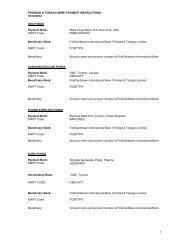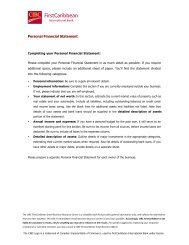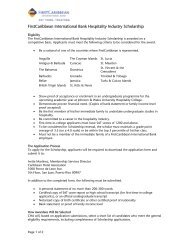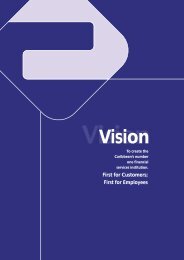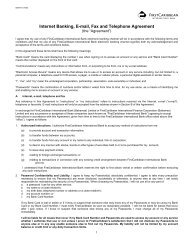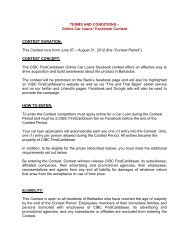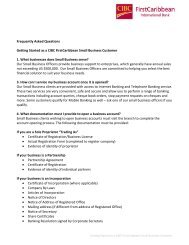(Jamaica) Limited - FirstCaribbean International Bank
(Jamaica) Limited - FirstCaribbean International Bank
(Jamaica) Limited - FirstCaribbean International Bank
You also want an ePaper? Increase the reach of your titles
YUMPU automatically turns print PDFs into web optimized ePapers that Google loves.
notes to the Financial Statements<br />
Year Ended 31 October 2009<br />
(Expressed in <strong>Jamaica</strong>n dollars unless otherwise indicated)<br />
36. Critical Accounting Judgements and Estimates in Applying Accounting Policies<br />
Estimates and judgements are continually evaluated and are based on historical experience and other factors, including<br />
expectations of future events that are believed to be reasonable under the circumstances. The estimates and judgements<br />
that have a significant risk of causing material adjustments to the carrying amounts of assets and liabilities within the next<br />
financial year are discussed below.<br />
(a) Impairment losses on loans and advances<br />
The Group reviews its loan portfolios to assess impairment at least on a quarterly basis. In determining whether<br />
an impairment loss should be recorded in the statement of income, the Group makes judgements as to whether<br />
there is any observable data indicating that there is a measurable decrease in the estimated future cash flows<br />
from a portfolio of loans before the decrease can be identified with an individual loan in that portfolio. This<br />
evidence may include observable data indicating that there has been an adverse change in the payment status<br />
of borrowers in a group, or national or local economic conditions that correlate with defaults on assets in the<br />
group. Management uses estimates based on historical loss experience for assets with credit risk characteristics<br />
and objective evidence of impairment similar to those in the portfolio when scheduling its future cash flows.<br />
The methodology and assumptions used for estimating both the amount and timing of future cash flows are<br />
reviewed regularly to reduce any differences between loss estimates and actual loss experience.<br />
(b) Retirement benefit obligations<br />
Accounting for some retirement benefit obligations requires the use of actuarial techniques to make a reliable<br />
estimate of the amount of benefit that employees have earned in return for their service in the current and<br />
prior periods. These actuarial assumptions are based on managements’ best estimates of the variables that<br />
will determine the ultimate cost of providing post-employment benefits and comprise both demographic and<br />
financial assumptions. This includes assumptions about discount rates, expected rates of return on assets, future<br />
salary increases, mortality rates and future pension increases. Variations in the financial assumptions can cause<br />
material adjustments in future years, if it is determined that the actual experience differed from the estimate.<br />
(c) Property, plant and equipment<br />
Management exercises judgment in determining whether costs incurred can accrue significant future economic<br />
benefits to the Group to enable the value to be treated as a capital expense.<br />
Further judgment is applied in the annual review of the useful lives of all categories of property, plant and<br />
equipment and the resulting depreciation determined thereon.<br />
93



